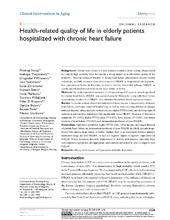| dc.description.abstract | Background: Chronic heart failure is a very common condition in the elderly, characterized not only by high mortality rates, but also by a strong impact on health-related quality of life (HRQOL). Previous studies of HRQOL in elderly heart failure subjects have included mostly outpatients, and little is known about determinants of HRQOL in hospitalized elderly population, especially in Serbia. In this study, we tried to identify factors that influence HRQOL in elderly patients hospitalized with chronic heart failure in Serbia. Methods: The study population consisted of 136 patients aged 65 years or older hospitalized for chronic heart failure. HRQOL was assessed using the Minnesota Living with Heart Failure questionnaire. Predictors of HRQOL were identified by multiple linear regression analysis. Results: Univariate analysis showed that patients with lower income, a longer history of chronic heart failure, and longer length of hospital stay, as well as those receiving aldosterone antagonists and digoxin, taking multiple medications, in a higher NYHA class, and showing signs of depression and cognitive impairment had significantly worse HRQOL. Presence of depressive symptoms (P<0.001), higher NYHA class (P=0.021), lower income (P=0.029), and longer duration of heart failure (P=0.049) were independent predictors of poor HRQOL. Conclusion: Depressive symptoms, higher NYHA class, lower income, and longer duration of chronic heart failure are independent predictors of poor HRQOL in elderly patients hospitalized with chronic heart failure in Serbia. Further, there is an association between multiple medication usage and poor HRQOL, as well as a negative impact of cognitive impairment on HRQOL. Hence, measures should be implemented to identify such patients, especially those with depressive symptoms, and appropriate interventions undertaken in order to improve their HRQOL. | en_US |

